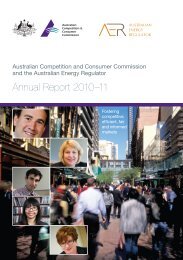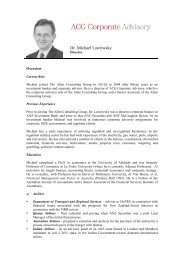Transend - Appendix 5 Renewal capital expenditure - Australian ...
Transend - Appendix 5 Renewal capital expenditure - Australian ...
Transend - Appendix 5 Renewal capital expenditure - Australian ...
Create successful ePaper yourself
Turn your PDF publications into a flip-book with our unique Google optimized e-Paper software.
Burnie-Waratah 110 kV Transmission Line Wood Poles<br />
TNM-CR-808-0888<br />
Issue 1.0, November 2008<br />
In 2006 an evaluation 1 was conducted into replacing the wood poles with steel poles, as and when<br />
they were condemned. The report looked at replacing both wood poles in the structure with steel<br />
poles. The report found that there was a whole of life premium of 14 per cent in replacing two<br />
treated wood poles with two modern steel poles. However, the benefits of steel structures in<br />
comparison to wood structures are numerous including:<br />
(a) improved resistance to fire (both pole and pole top);<br />
(b) unlike some wood poles, steel poles do not leach chemicals into the soil;<br />
(c) greater availability; and<br />
(d) significantly lighter than wood poles.<br />
The only negative aspect of a steel pole is the potential for corrosion. However, through the<br />
utilisation of galvanised surfaces, top and bottom pole caps, and HDPE sleeve at the ground to air<br />
interface, the risk of corrosion is sufficiently mitigated, resulting in a life expectancy of<br />
approximately 75 years.<br />
Due to these advantages, <strong>Transend</strong> investigated whether further cost savings could be obtained<br />
through the replacement of two wood poles with a single steel pole. It was found that this was<br />
technically feasible and the cost per suspension tower replacement was approximately 16 per cent<br />
cheaper than utilising two wood poles.<br />
Based on this evaluation it was decided that a new structure using only one steel pole would be a<br />
viable alternative for suspension structures with the two steel pole replacements being adopted for<br />
the strain structures.<br />
2.4 SPARE PARTS AND CONTINGENCY PLANNING<br />
<strong>Transend</strong> has a small number of steel poles to cater for contingency events and can source wood<br />
poles from local suppliers in emergencies.<br />
2.5 SAFETY<br />
As detailed within <strong>Transend</strong>’s Transmission Line Support Structures Asset Management Plan<br />
(TNM-SY-808-0223), the risk of some aged wood poles failing and causing the transmission line<br />
conductor to fall and either cause a fire or expose line workers or the public to a safety hazard is<br />
high. The risk mitigation actions recommended in this instance are to inspect, test and replace<br />
(where needed) affected structures.<br />
2.6 ENVIRONMENT<br />
Environmental risks include the possibility of a bushfire start and the inappropriate disposal of the<br />
Copper Chrome Arsenate (CCA) 2 impregnated wood poles.<br />
3 ASSET MANAGEMENT OPTIONS<br />
The costing comparisons associated with the following options are contained in the 2006<br />
evaluation report (see footnote 2).<br />
1 Hydro Tasmania Consulting report ’110kV Burnie-Waratah transmission line comparative cost study of<br />
Sureline Steel poles as an alternative replacement for condemned wood poles’ dated 7 June 2006.<br />
2 CCA is a mixture of inorganic components containing the elements copper, chromium and arsenic. Lebow<br />
(1996) explains that the primary role of chromium is in CCA fixation, through a complex series of reactions<br />
driven by its reduction from the hexavalent state to the trivalent state after it is applied to the wood. Copper<br />
and arsenic provide the efficacy of the preservative, copper primarily as a fungicide, and arsenic more for its<br />
activity as an insecticide, and also for activity against copper-tolerant fungi. Cookson (2001) claims that<br />
while arsenic was originally thought to be needed for insect control, the latest theory is that arsenic is more<br />
useful in controlling copper-tolerant brown rotting fungi.<br />
Page 8 of 9 © <strong>Transend</strong> Networks Pty Ltd<br />
UNCONTROLLED WHEN PRINTED







